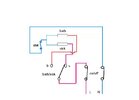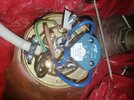Yes, slightly - but,as I've been saying, in practice that is really not much of an issue.I see where you're coming from, but as the hot water rises through the cylinder from the bottom it will definitely dissipate heat into the surrounding body of water on its way to the top. I understand it will be hottest at the top though.
With my single-element cylinder if, starting from cold, I switch on the bottom) element for long enough for the top ~20% (probably about 28 litres) to 'feel very hot', the middle, let alone bottom of the cylinder still remains pretty cold to the touch.
Again, all theoretically/strictly true but, in practice, probably not much of an issue. As I've just written to Harry, if it were me I probably wouldn't feel that the cost/disruption of getting a new cylinder and a couple of new immersions would be 'worthwhile' - but that is obviously you'r decision.By minimising the distance the hot water has to travel, you minimise the heat loss into the water in the rest of the tank (which you don't need). That said you are probably anecdotally correct in that sticking a boost on for an hour will sort it either way from a practical perspective. But you will have "wasted" some energy.
Kind Regards, John



